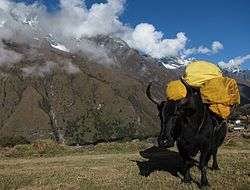Dzo
| Dzo | |
|---|---|
 | |
| A dzo acting as a pack animal en route to Mount Everest | |
| Domesticated | |
| Scientific classification | |
| Kingdom: | Animalia |
| Phylum: | Chordata |
| Class: | Mammalia |
| Order: | Artiodactyla |
| Family: | Bovidae |
| Subfamily: | Bovinae |
| Tribe: | Bovini |
| Genus: | Bos |
| Species: | B. grunniens × B. primigenius |
A dzo (Tibetan མཛོ་ mdzo) (also spelled zo, zho and dzho) is a hybrid between the yak and domestic cattle. The word dzo technically refers to a male hybrid, while a female is known as a dzomo or zhom. In Mongolian it is called khainag (хайнаг). There is also the English language portmanteau term of yakow; a combination of the words yak and cow, though this is rarely used.
Dzomo are fertile (or, fecund) while dzo are sterile. As they are a product of the hybrid genetic phenomenon of heterosis (hybrid vigor), they are larger and stronger than yak or cattle from the region.[1] In Mongolia and Tibet, khainags are thought to be more productive than cattle or yaks in terms of both milk and meat production.[2][3]
Dzomo can be back crossed. As a result, many supposedly pure yak or pure cattle probably carry each other's genetic material. In Mongolia and Tibet, the result of a khainag crossed with either a domestic bull or yak bull is called ortoom (three-quarter-bred) and an ortoom crossed with a domestic bull or yak bull results in a usan güzee (one-eighth-bred).[3][4]
See also
References
- ↑ David B. Madsen; Fa-Hu Chen; Xing Gao (3 July 2007). Late Quaternary Climate Change and Human Adaptation in Arid China. Elsevier. p. 207. ISBN 978-0-444-52962-6. Retrieved 3 June 2012.
- ↑ Bataagiin Bynie: Mongolia: The Country Refort (sic!) On Animal Genetic Resources, Ulaanbaatar 2002, p. 11
- 1 2 Tsering, Diki (2002). Dalai Lama, My Son. Penguin Books. ISBN 0-7865-2260-7.
- ↑ Takase Hisabumi, Kh. Tumennasan et al., Fertility Investigation in F1 Hybrid and Backcross Progeny of Cattle (Bos taurus) and Yak (B. gruniens) in Mongolia. : II. Little variation in gene products studied in male sterile and fertile animals, in: Niigata journal of health and welfare Vol.2, No.1, pp. 42-52
External links
| Wikimedia Commons has media related to Dzo. |
| Look up dzo in Wiktionary, the free dictionary. |